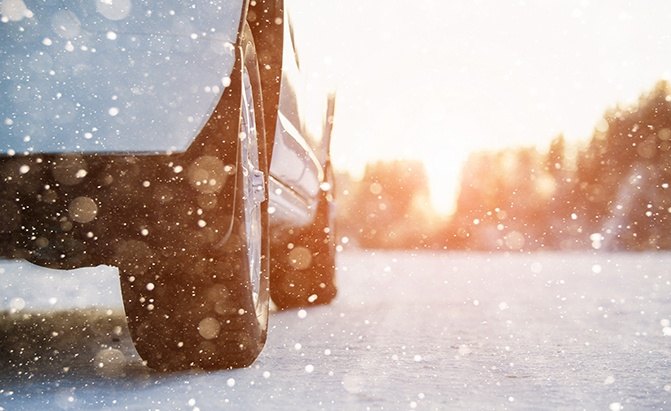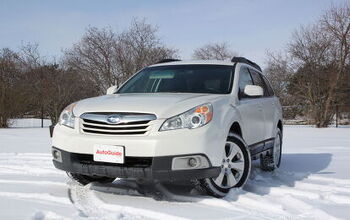Cooper Evolution Winter Review

When I reached out to the folks at Cooper Tires for a set of Evolution Winter tires to test, they were hesitant. Instead, they suggested the Discoverer True North, a more “mainstream” winter tire.
You see, the Evolution Winter is designed specifically for driving in deep snow, so even if winter is a season in your neck of the woods, these might not be the tire for you.
We had already tested the True North tires though and I figured deep snow wouldn’t be an issue. “I live in Canada,” I said. And that’s all the convincing it took.
Now, I should point out that I live in suburban Toronto, which, to most Canadians doesn’t really qualify as much of a winter. Still, last year we got piles of snow and the well-worn (or well-worn-out) budget brand winter tires I had been rolling on were definitely at the end of their lifecycle.
Read our detailed Cooper Evolution Winter Review below.
SEE ALSO: Cooper Tires Discoverer True North Winter Tire ReviewPros | Fantastic in deep snow, Better than expected real-world treadwear, Studdable |
Cons | Not for everyone |
Bottom Line | An extreme winter tire ideal for those in extreme winter climates |
Table of contents
Features
These tires really don’t look like anything impressive. The tread pattern isn’t full of complicated features. Instead, they’re a simple five-row setup with larger exterior tread blocks and a pretty non-descript middle three rows.
There’s plenty of siping on every tread block to grab the snow and available holes for studs – in case you really live up a long driveway on a mountain, or in a Subaru commercial.
Perhaps the only really noteworthy design element is that the center rib has what Cooper calls a “sawtooth” design, with blocks that are offset from each other. This gives the tire a wider center rib at speed, delivering superior stability on snow-covered roads. And if you’ve ever driven in deep snow you know how ruts can pull you back and forth, so this is a definite plus.
Real World Experience
One of the small joys of swapping on winter tires is that they are almost always more comfortable than summers or all-seasons. The squishy sidewalls that are often a higher profile than the summers, paired with the softer tread compound is a welcome change.
A usual down side, however, is the added noise. That’s partially true here. While hardly loud, they do emit more drone than a typical all-season – but that’s to be expected of pretty much any winter tire.
Contrary to what I had expected, this past winter was not like the one previous. Snow was not plentiful and a worldwide pandemic meant my daily commute just evaporated.
Still, I had several opportunities during my early morning commute to get out on roads well in advance of the plows. It was these moments that had prompted me to request these specific tires in the first place. While there are massive benefits to winter tires in general (I’ll get to that in a second), my biggest concern is that it’s on these particularly “Canadian” mornings, where you’re driving on so much snow you can’t even tell where the side of the road ends, that you want the most grip possible.
I was thrilled to realize that the Evolution Winter delivers exactly as promised. Even with decent winter tires I find that leaving the driveway and heading up the mild grade of my street I’m met with plenty of slipping. Not so here. The tires gripped immediately. Getting rolling from a stop was not an issue. Likewise, at the end of my street where the plow had already been by, leaving a snowbank for me to break through. I’d normally fret over this, wondering if I’d make it through, but the Evolution Winters made easy work of it.
Further on, my morning commute includes a bit of a shortcut that runs between subdivisions, taking some rural roads. These 50 mph (80 km/h for Canadian readers) roads were, as expected, untouched by plows and provided the truest test of the capability of the tire. I was easily able to accelerate up to speed and maintain my desired trajectory without having to wrestle with the steering wheel. What had often been a rather harrowing experience in past snowstorms was now a non-event. It’s amazing what confidence can do.
As work-from-home took the world by storm, my morning commutes disappeared and I never did put as many miles on these tires as I had intended. As a result, I didn’t plan on being surprised when I swapped my all-seasons back on, but I was. The Coopers didn’t just look minimally-worn, they looked brand new!
Warranty
Cooper backs all of its tires with a industry-standard warranty that covers defects during the first 2/32-inch treadwear and will replace tires found to be with issue within that period. Defects found after that period will be eligible for a pro-rated replacement. Like all snow tires there is no mileage warranty on the tires, but Cooper does offer a 45-Day Test Drive Warranty on this tire meaning they will replace any tire with the same type of you’re not completely satisfied.
Sizes
The Cooper Evolution Winter is available in a wide variety of sizes with 67 different fitments from 14- to 20-inches and ranging from a tiny 175 width to a robust 265 width.
I always say that even the worst winter tires are better than all-seasons. And that’s fundamentally true. Winter tires grip better in cold weather (below 7 degrees celsius or 45 degrees Farenheit) so you don’t really need to have snow to need winter tires.
It’s also important to point out that most folks do their driving early in the morning and later in the evening… during rush hour. So don’t look at the daily high, but at the daily low, to get a better idea of when you should switch to winter tires.
Winter Tires vs Snow Tires
These terms are often used interchangeably. In reality, when people talk about snow tires, they really mean winter tires.
Perhaps confusing matters are tires like the Evolution Winter. As far as winter tires go, they really are “snow tires.”
If you’re not sure what is or is not a winter tire, look for the three-peak mountain snowflake symbol on the sidewall. Don’t be fooled by the M+S (mud and snow) rating. That does not make it a snow tire or winter tire.
Winter is Coming!
As the days grow shorter and the leaves start to change, it’s already time to start thinking about winter tires. So take a look at your own. And don’t be fooled by the tread depth, instead, take a look at the siping on the tires. Often winter tires still have tread left but the siping has been worn off. If that’s the case for you, it’s time for a new set of tires.
This year I’m compelled to point out that during the summer I noticed a lot of cars still driving around on winters. This is likely as a result of the pandemic that meant many folks couldn’t get their tires swapped out back in March or April and then just never bothered to do so once they did have the opportunity.
Not only is this dangerous (winter tires make for pretty terrible grip in the heat), these folks have most certainly now destroyed their winter tires and will need a new set before the season begins.
Our Final Verdict

With AutoGuide from its launch, Colum previously acted as Editor-in-Chief of Modified Luxury & Exotics magazine where he became a certifiable car snob driving supercars like the Koenigsegg CCX and racing down the autobahn in anything over 500 hp. He has won numerous automotive journalism awards including the Best Video Journalism Award in 2014 and 2015 from the Automotive Journalists Association of Canada (AJAC). Colum founded Geared Content Studios, VerticalScope's in-house branded content division and works to find ways to integrate brands organically into content.
More by Colum Wood





































Comments
Join the conversation
What size stud do I need 255/50r/20cooper evaluation
After just reading a nearly unintelligible review on a different site, reading yours not only CONFIRMED that these are the tires I want (I live at 9000 feet, in Coloroado) but reading your review was just a pure pleasure, confirming that you know what it is that a true winter tire buyer wants to know. Thanks.